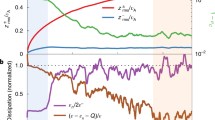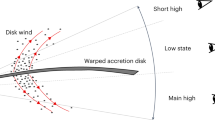Abstract
THE flow of supersonic solar wind is supposed to be reduced to subsonic velocities and randomized at a so-called shock front somewhere between 5 and 50 AU from the Sun. The position of the shock front is roughly determined by the condition that the energy density of the solar wind plasma should be comparable with that of the interstellar magnetic field. Patterson et al.1 have found that half the flux of the solar wind protons is returned to the heliosphere at the shock front in the form of fast neutral hydrogen atoms produced in charge exchange processes supposed to take place in a thin shell around the shock front. This return flux is a consequence of the thin shell model and the assumption that all the solar wind protons which pass the shock front undergo charge exchange with interstellar hydrogen.
This is a preview of subscription content, access via your institution
Access options
Subscribe to this journal
Receive 51 print issues and online access
$199.00 per year
only $3.90 per issue
Buy this article
- Purchase on Springer Link
- Instant access to full article PDF
Prices may be subject to local taxes which are calculated during checkout
Similar content being viewed by others
References
Patterson, I. N. L., Johnson, F. S., and Hanson, W. B., Planet. Space Sci., 11, 767 (1963).
Hundhausen, A. J., Planet. Space Sci., 16, 783 (1968).
Author information
Authors and Affiliations
Rights and permissions
About this article
Cite this article
BLUM, P., FAHR, H. Solar Wind Tail and the Anisotropic Production of Fast Hydrogen Atoms. Nature 223, 936–937 (1969). https://doi.org/10.1038/223936b0
Received:
Revised:
Issue Date:
DOI: https://doi.org/10.1038/223936b0
This article is cited by
-
Heliosheath Processes and the Structure of the Heliopause: Modeling Energetic Particles, Cosmic Rays, and Magnetic Fields
Space Science Reviews (2017)
-
Pressure and Ionization Balances in the Circum-Heliospheric Interstellar Medium and the Local Bubble
Space Science Reviews (2009)
-
Interaction of interstellar pick-up ions with the solar wind
Astrophysics and Space Science (1988)
-
Solar wind heating beyond 1 AU
Astrophysics and Space Science (1973)
-
Galactic Lyman Alpha and the Interstellar Shock Wave
Nature (1970)
Comments
By submitting a comment you agree to abide by our Terms and Community Guidelines. If you find something abusive or that does not comply with our terms or guidelines please flag it as inappropriate.



